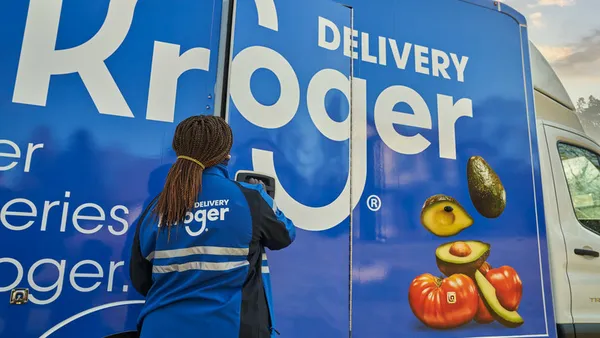Grocery inflation to on track to continue coming down during the coming months, but food prices are unlikely to return to their levels from two years ago, Walmart President and CEO Doug McMillon said Tuesday during Goldman Sachs’ 30th annual Global Retailing Conference.
“Inflation and higher prices are kind of with us. We'll see disinflation, but not all the way back to deflation ... certainly not in the short term,” McMillon said, adding that he would like to have lower prices faster for consumers.
“What we've seen over the last few years has resulted in dry grocery/consumables having a pretty big two-year stack inflation number and that's coming down a little bit but not a lot,” McMillon said.
McMillon’s comments came a day prior to the Consumer Price Index data for August, which was released Wednesday by the U.S. Bureau of Labor Statistics, and showed that food-at-home prices during the month increased at a 3% annual pace while overall inflation rose to 3.7%.
On the consumer behavior front, McMillon said that the job market, wage increases and some pockets of disinflation have helped spending.
“In the U.S. things are better than I would have expected them to be when we started the year,” he said. “I was concerned about the amount of inflation in categories like dry grocery, consumables [and] how that would impact discretionary purchases.”
Walmart's comparable sales growth of 6.4% in its second quarter was driven by grocery and health and wellness with an offset by softness in general merchandise.
For shoppers with constrained budgets, the retailer has seen behavioral changes, like switching to private brands, to alleviate pressure on their wallets. Walmart’s ability to attract customers across income cohorts “has improved our situation,” McMillon said.
The retailer’s strong results at the end of its second quarter and the back-to-school season indicate it will have well-performing holiday sales, McMillon said. He added that Walmart is confident about its ability to maintain price gaps as it manages the cost increases and decreases it sees from suppliers.
Walmart’s prices will likely be slightly lower in 2024 than this year but higher than two years ago, McMillon said, noting that the retailer’s price gaps are “in a healthy place.”
Inventory management and increasing productivity with its supply chain are top priorities for Walmart, he added.
“I've been doing this now for more than 32 years, and I've never seen an opportunity to step change the supply chain like the one that's right in front of us,” McMillon said.
Robotics, algorithm improvements, data usage and automation are fueling the supply chain updates, he said, highlighting Walmart’s work over the last seven years to figure out how to make automated storage and retrieval systems work successfully.
“Specifically, automated storage and retrieval systems placed into our ambient DC network, our perishable distribution center network, our e-commerce fulfillment centers and our fulfillment centers that will be on-locations with many of our stores — when you put those things together, we touch the product a lot less,” McMillon said.
He continued: “Our accuracy is a lot higher. Productivity will go up in the backroom of the store as we receive freight that is palletized in a more accurate [way that] relates to what's needed in a department or an aisle over time. That is a change that we've dreamt about and haven't been capable of doing.”
While Walmart wants to grow its Walmart+ membership base, McMillon said the company will continue to shy away from sharing its membership numbers publicly: “We don't want to accidentally create some shorthand where you all value our whole company based on on that singular metric, which we've seen happen with some other other companies.”
As the company updates Walmart+ — with recent changes including the rollout of Walmart+ Assist for consumers who participate in government assistance programs and the addition of Expedia travel perks — it’s looking for “organic repeat and bigger share” among members, he said.
“They're going to be different types of memberships, not only at Walmart but at Sam's Club and in other places,” he said, without providing additional details on what those memberships would be.
In 2024, McMillon said he expects consumers will have about the same headwinds and about the same spending levels as in 2023.
“I don't know exactly what's going to happen 12 months from now, but it feels like because of employment, wages, some disinflation that things can kind of hang in where they are,” he said.
Walmart’s prices will likely be slightly lower in 2024 than this year but higher than two years ago, he said, noting that the retailer’s price gaps are “in a healthy place.”
Walmart wants investors to know it isn’t worried about the year ahead: “If people are more value-conscious, they come our way,” McMillon said.












